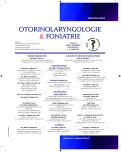Cervical Dissection of Thyroid Gland Tumors at ORL Wards in the Czech Republic – Evaluation of the Questionnaire and a Recommendation for Unification of Surgical Procedures
Authors:
P. Čelakovský 1; J. Plzák 2; Viktor Chrobok
Authors‘ workplace:
Klinika otorinolaryngologie a chirurgie hlavy a krku LF UK a FN v Hradci Králové
; přednosta prof. MUDr. V. Chrobok, CSc., Ph. D.
Klinika otorinolaryngologie a chirurgie hlavy a krku 1. LF UK a FN v Motole, Praha
1; přednosta prof. MUDr. J. Betka, DrSc., FCMA
2
Published in:
Otorinolaryngol Foniatr, 63, 2014, No. 2, pp. 90-93.
Category:
Review Article
Overview
The authors summarize the knowledge about opinions and the actually performed practice concerning the indications and extent of cervical dissections in the thyroid gland carcinoma at ORL workplaces of the Czech Republic. The information was obtained by using questionnaires, having been sent to 55 bed wards. Twenty seven (49%) of the wards responded. Seventeen wards sent back the filled out questionnaires, 10 wards indicated that thyroid gland surgery was not performed there.
The results indicate that surgical procedures at the individual ORL wards were not the same. The differences concern especially indications for elective cervical dissections and their extent in well differentiated carcinomas as well as in medullar carcinoma. A broader discussion and adhering to recommendations of larger international professional associations (e.g. European Thyroid Association) can contribute to unification of the procedures. The individual decision making for specific patients requires an interdisciplinary discussion with endocrinologists and specialists of other medical branches.
Keywords:
papillary carcinoma, follicular carcinoma, medullar carcinoma, cervical dissection
Sources
1. British Thyroid Association, Royal College of Physicians: Guidelines for the management of thyroid cancer. Second edition, 2007, s. 92.
2. Cooper, D. S., Doherty, G. M., Haugen, B. R. et al.: Revised American thyroid association management guidelines for patients with thyroid nodules and differentiated thyroid cancer. Thyroid, 19, 2009, s. 1167-1214.
3. McLeod, D. S. A., Sawka, A. M., Cooper, D. S.: Controversies in primary treatment of low-risk papillary thyroid cancer. Lancet, 381, 2013, s. 1046-1057.
4. Pacini, F., Schlumberger, M., Dralle, H. et al.: European consensus for the management of patients with differentiated thyroid carcinoma of the follicular epithelium. Eur. J. Endocrinol., 154, 2006, s. 787-803.
5. Pitoia, F., Ward, L., Wohllk, N. et al.: Recommendations of the Latin American thyroid society on diagnosis and management of differentiated thyroid cancer. Arq. Bras. Endocrinol. Metab., 53, 2009, s. 884-897.
6. Plzák, J., Astl, J., Psychogios, G., Zenk, J., Laštůvka, P., Betka, J.: Current treatment strategies for papillary thyroid microcarcinoma. HNO, 61, 2013, s. 300-305.
7. Takami, H., Ito, Y., Okamoto, T., Yoshida, A.: Therapeutic strategy for differentiated thyroid carcinoma in Japan based on a newly established guideline managed by Japanese society of thyroid surgeons and Japanese association of endocrine surgeons. World. J. Surg., 35, 2011, s. 111-121.
Labels
Audiology Paediatric ENT ENT (Otorhinolaryngology)Article was published in
Otorhinolaryngology and Phoniatrics

2014 Issue 2
Most read in this issue
- Branchiogenic Nasopharyngeal Cyst
- Free Flaps in Reconstruction of Extensive Defects after Oncological Head and Neck Surgery
- Diagnostics of Extraesophageal Reflux in Children with Chronic Otitis Media with Effusion
- Does Antibiotic Therapy Influence Pain after Tonsillectomy?
